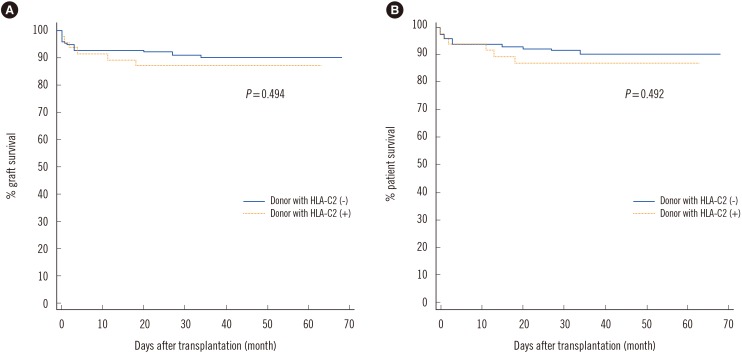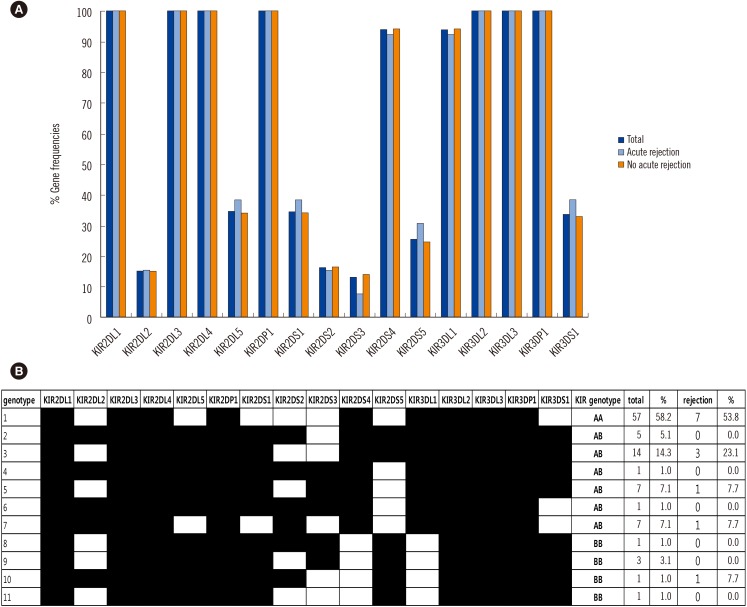Ann Lab Med.
2017 Jan;37(1):45-52. 10.3343/alm.2017.37.1.45.
Human Leukocyte Antigen-C Genotype and Killer Immunoglobulin-like Receptor-Ligand Matching in Korean Living Donor Liver Transplantation
- Affiliations
-
- 1Department of Laboratory Medicine, Seoul St. Mary's Hospital, College of Medicine, the Catholic University of Korea, Seoul, Korea. ejoh@catholic.ac.kr
- 2Department of Biomedical Science, Graduate School, the Catholic University of Korea, Seoul, Korea.
- 3Department of Surgery, Seoul St. Mary's Hospital, College of Medicine, the Catholic University of Korea, Seoul, Korea.
- KMID: 2373613
- DOI: http://doi.org/10.3343/alm.2017.37.1.45
Abstract
- BACKGROUND
The interaction between killer immunoglobulin-like receptors (KIRs) and HLA class I regulates natural killer (NK) cell cytotoxicity and function. The impact of NK cell alloreactivity through KIR in liver transplantation remains unelucidated. Since the frequency of HLA-C and KIR genotypes show ethnic differences, we assessed the impact of HLA-C, KIR genotype, or KIR-ligand mismatch on the allograft outcome of Korean liver allografts.
METHODS
One hundred eighty-two living donor liver transplant patients were studied. Thirty-five patients (19.2%) had biopsy-confirmed acute rejection (AR), and eighteen (9.9%) had graft failure. The HLA-C compatibility, KIR genotypes, ligand-ligand, and KIR-ligand matching was retrospectively investigated for association with allograft outcomes.
RESULTS
Homozygous C1 ligands were predominant in both patients and donors, and frequency of the HLA-C2 allele in Koreans was lower than that in other ethnic groups. Despite the significantly lower frequency of the HLA-C2 genotype in Koreans, donors with at least one HLA-C2 allele showed higher rates of AR than donors with no HLA-C2 alleles (29.2% vs 15.7%, P=0.0423). Although KIR genotypes also showed ethnic differences, KIR genotypes and the number of activating KIR/inhibitory KIR were not associated with the allograft outcome. KIR-ligand mismatch was expected in 31.6% of Korean liver transplants and had no impact on AR or graft survival.
CONCLUSIONS
This study could not confirm the clinical impact of KIR genotypes and KIR-ligand mismatch. However, we demonstrated that the presence of HLA-C2 allele in the donor influenced AR of Korean liver allografts.
Keyword
MeSH Terms
-
Adult
Alleles
Asian Continental Ancestry Group/*genetics
Female
Genotype
Graft Rejection
Graft Survival
HLA-C Antigens/*genetics
Homozygote
Humans
Killer Cells, Natural/cytology/immunology
Ligands
*Liver Transplantation
Male
Middle Aged
Proportional Hazards Models
Receptors, KIR/chemistry/*genetics/metabolism
Republic of Korea
Tissue Donors
Transplantation, Homologous
HLA-C Antigens
Ligands
Receptors, KIR
Figure
Reference
-
1. Kitchens WH, Uehara S, Chase CM, Colvin RB, Russell PS, Madsen JC. The changing role of natural killer cells in solid organ rejection and tolerance. Transplantation. 2006; 81:811–817. PMID: 16570001.2. Beilke JN, Kuhl NR, Van Kaer L, Gill RG. NK cells promote islet allograft tolerance via a perforin-dependent mechanism. Nat Med. 2005; 11:1059–1065. PMID: 16155578.3. Yu G, Xu X, Vu MD, Kilpatrick ED, Li XC. NK cells promote transplant tolerance by killing donor antigen-presenting cells. J Exp Med. 2006; 203:1851–1858. PMID: 16864660.4. Ljunggren HG. In search of the 'missing self': MHC molecules and NK cell recognition. Immunol Today. 1990; 11:237–244. PMID: 2201309.5. Tran TH, Unterrainer C, Fiedler G, Döhler B, Scherer S, Ruhenstroth A, et al. No impact of KIR-ligand mismatch on allograft outcome in HLA-compatible kidney transplantation. Am J Transplant. 2013; 13:1063–1068. PMID: 23398855.6. Moretta A, Sivori S, Vitale M, Pende D, Morelli L, Augugliaro R, et al. Existence of both inhibitory (p58) and activatory (p50) receptors for HLA-C molecules in human natural killer cells. J Exp Med. 1995; 182:875–884. PMID: 7650491.7. Biassoni R, Falco M, Cambiaggi A, Costa P, Verdiani S, Pende D, et al. Amino acid substitutions can influence the natural killer (NK)-mediated recognition of HLA-C molecules. Role of serine-77 and lysine-80 in the target cell protection from lysis mediated by "group 2" or "group 1" NK clones. J Exp Med. 1995; 182:605–609. PMID: 7629517.8. Legaz I, López-Álvarez MR, Campillo JA, Moya-Quiles MR, Bolarín JM, de la, et al. KIR gene mismatching and KIR/C ligands in liver transplantation: consequences for short-term liver allograft injury. Transplantation. 2013; 95:1037–1044. PMID: 23478359.9. Hanvesakul R, Spencer N, Cook M, Gunson B, Hathaway M, Brown R, et al. Donor HLA-C genotype has a profound impact on the clinical outcome following liver transplantation. Am J Transplant. 2008; 8:1931–1941. PMID: 18671674.10. Moya-Quiles MR, Alvarez R, Miras M, Gomez-Mateo J, Lopez-Alvarez MR, Marin-Moreno I, et al. Impact of recipient HLA-C in liver transplant: a protective effect of HLA-Cw*07 on acute rejection. Hum Immunol. 2007; 68:51–58. PMID: 17207712.11. López-Alvarez MR, Moya-Quiles MR, Minguela A, Gil J, Miras M, Campillo JA, et al. HLA-C matching and liver transplants: donor-recipient genotypes influence early outcome and CD8+KIR2D+ T-cells recuperation. Transplantation. 2009; 88(3 Suppl):S54–S61. PMID: 19667963.12. Moya-Quiles MR, Muro M, Torío A, Sánchez-Bueno F, Miras M, Marín L, et al. Human leukocyte antigen-C in short- and long-term liver graft acceptance. Liver Transpl. 2003; 9:218–227. PMID: 12619017.13. Bishara A, Brautbar C, Zamir G, Eid A, Safadi R. Impact of HLA-C and Bw epitopes disparity on liver transplantation outcome. Hum Immunol. 2005; 66:1099–1105. PMID: 16571410.14. Tran TH, Middleton D, Döhler B, Scherer S, Meenagh A, Sleator C, et al. Reassessing the impact of donor HLA-C genotype on long-term liver transplant survival. Am J Transplant. 2009; 9:1674–1678. PMID: 19392983.15. Cao K, Hollenbach J, Shi X, Shi W, Chopek M, Fernández-Viña MA. Analysis of the frequencies of HLA-A, B, and C alleles and haplotypes in the five major ethnic groups of the United States reveals high levels of diversity in these loci and contrasting distribution patterns in these populations. Hum Immunol. 2001; 62:1009–1030. PMID: 11543903.16. Banff schema for grading liver allograft rejection: an international consensus document. Hepatology. 1997; 25:658–663. PMID: 9049215.17. Na GH, Kim EY, Hong TH, You YK, Kim DG. Effects of preoperative positive cross-match and HLA mismatching on early acute cellular rejection and graft survival in living donor liver transplantation. Ann Transplant. 2015; 20:553–560. PMID: 26377312.18. Gagne K, Brizard G, Gueglio B, Milpied N, Herry P, Bonneville F, et al. Relevance of KIR gene polymorphisms in bone marrow transplantation outcome. Hum Immunol. 2002; 63:271–280. PMID: 12039408.19. Moroso V, van der Meer A, Tilanus HW, Kazemier G, van der Laan LJ, Metselaar HJ, et al. Donor and recipient HLA/KIR genotypes do not predict liver transplantation outcome. Transpl Int. 2011; 24:932–942. PMID: 21672051.20. van Bergen J, Thompson A, Haasnoot GW, Roodnat JI, de Fijter JW, Claas FH, et al. KIR-ligand mismatches are associated with reduced long-term graft survival in HLA-compatible kidney transplantation. Am J Transplant. 2011; 11:1959–1964. PMID: 21714849.21. Chewning JH, Gudme CN, Hsu KC, Selvakumar A, Dupont B. KIR2DS1-positive NK cells mediate alloresponse against the C2 HLA-KIR ligand group in vitro. J Immunol. 2007; 179:854–868. PMID: 17617576.22. Foley B, De Santis D, Lathbury L, Christiansen F, Witt C. KIR2DS1-mediated activation overrides NKG2A-mediated inhibition in HLA-C C2-negative individuals. Int Immunol. 2008; 20:555–563. PMID: 18308713.23. Michelo CM, van der Meer A, Tijssen HJ, Zomer R, Stelma F, Hilbrands LB, et al. KIR and Human Leukocyte Antigen genotype associated risk of cytomegalovirus disease in renal transplant patients. Transplantation. 2015; 99:1506–1513. PMID: 25427165.24. Kim HJ, Choi HB, Jang JP, Baek IC, Choi EJ, Park M, et al. HLA-Cw polypmorphism and killer cell immunoglobulin-like receptor (KIR) gene analysis in Korean colorectal cancer patients. Int J Surg. 2014; 12:815–820. PMID: 24998207.25. Park H, Rho EY, In JW, Kim I, Yoon SS, Park S, et al. The impact of HLA and KIR ligand mismatching on unrelated allogeneic hematopoietic stem cell transplantation in Korean adult patients. Ann Lab Med. 2015; 35:111–117. PMID: 25553290.26. Cooley S, Trachtenberg E, Bergemann TL, Saeteurn K, Klein J, Le CT, et al. Donors with group B KIR haplotypes improve relapse-free survival after unrelated hematopoietic cell transplantation for acute myelogenous leukemia. Blood. 2009; 113:726–732. PMID: 18945962.27. Moesta AK, Norman PJ, Yawata M, Yawata N, Gleimer M, Parham P. Synergistic polymorphism at two positions distal to the ligand-binding site makes KIR2DL2 a stronger receptor for HLA-C than KIR2DL3. J Immunol. 2008; 180:3969–3979. PMID: 18322206.
- Full Text Links
- Actions
-
Cited
- CITED
-
- Close
- Share
- Similar articles
-
- Recipient's Killer Cell Immunoglobulin-like Receptor Genotype and Human Leukocyte Antigen C Ligand Influence the Clinical Outcome following Living Donor Liver Transplantation
- Graft-versus-host disease after living donor liver transplantation: A collective review of Korean cases
- Overcoming high pre-transplant isoagglutinin titers using high-dose intravenous immunoglobulin, salvage plasmapheresis, and booster rituximab without splenectomy in ABO-incompatible living donor liver transplantation: a case report
- Successful treatment of early acute antibody-mediated rejection in an human leukocyte antigen-incompatible and ABO-incompatible living-donor kidney transplant patient
- Liver retransplantation for adult recipients




